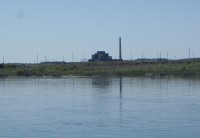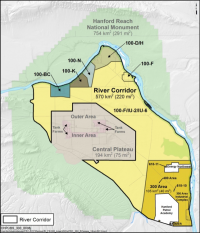On July 15th, the Tri-Party agencies, the U.S. Department of Energy, the U.S. Environmental Protection Agency (EPA), and the Washington State Department of Ecology, released their Proposed Plan for cleanup for forty square miles, ten along the Columbia River, on the southern corner of the Hanford Nuclear Reservation, also known as the 300 Area. The public has only thirty-two days, until, September 16th, to submit comments on the 300 Area Proposed Plan.
Submit a comment with Riverkeeper - sign our petition today!
Unfortunately, the Tri-Party agencies’ want to rely on experimental technology and natural attenuation to treat the pollutants in the soil and groundwater of southeast Hanford. This strategy demonstrably fails to protect the Columbia River from long lived pollutants such as uranium that seep into the groundwater and the river where they enter the food chain.
Here’s what we know about the Tri-party agencies preferred alternative. The agencies propose to remove, treat and dispose of soil from waste sites only as deep as 15 feet. They would forego removal of waste sites deep in the soil with the highest contribution of residual uranium to groundwater. Instead, the agencies would rely on enhanced attenuation and monitored natural attenuation. If all goes as planned, the groundwater will remain polluted for at least 22 years.
Enhanced attenuation is an experimental technology that claims to immobilize uranium deep in the soil, preventing it from contaminating the groundwater and Columbia River. However, Energy has not successfully field-tested its enhanced attenuation strategy and it does not plan to remove deep uranium if the proposed action is unsuccessful. Energy’s backup plan is to allow uranium to enter the Columbia River.
The agencies also propose allowing the radionuclides and chemicals including uranium isotopes, cesium-137, strontium-90, cobalt-60, and polychlorinated biphenyls to naturally attenuate. “Monitored natural attenuation” relies on natural processes, such as dilution, and radioactive decay, to decrease concentrations of contaminants. At the southern Hanford riverbank, pollutants will be left in the ground and allowed to migrate towards the groundwater and the Columbia River where they will be diluted. Basically, monitored natural attenuation is a “do nothing” approach that allows chemicals and radionuclides to flush into the Columbia River over time.
So how much uranium is in the riverbank? At this edge of the Site, uranium fuel rods were produced for use in Hanford’s nine nuclear reactors, and more than 33,565 kg of uranium was disposed into ponds. This resulted in persistent uranium contamination in the soil and groundwater. The resulting groundwater plume spans about 1 million cubic meters, the current dissolved uranium mass typically ranges from 40 to 80 kg. This plume contaminates 1,200 meters of Columbia River shoreline.
According to the EPA, uranium is carcinogenic due to its radioactivity, and chemically toxic to the body. Uranium is extremely persistent in the environment. Leaving uranium in the deep soil and allowing it to enter the Columbia River could pose serious threats to human and aquatic life in the Columbia River for countless generations.
We’ll be digging deeper into the agencies’ analysis and distilling the alternatives. The Tri-Party agencies are accepting public comments on the Proposed Plan through September 16th.
Click here to sign our petition to the U.S. Department of Energy





